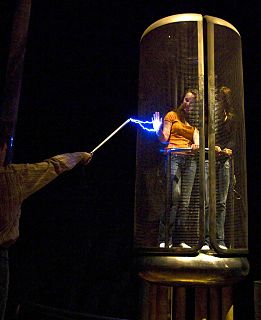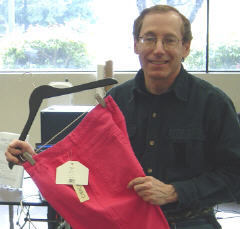See also
| This technology-related article is a stub. You can help Wikipedia by expanding it. |
An RSA blocker tag (or RSA tag) is a RFID tag that responds positively to all unauthorized requests, thus blocking some scanners from reading any RFID tags placed nearby. The tags are designed to protect privacy, and are supposedly unable to be used for theft, denials of service, and other malicious uses.
Other mechanisms designed to protect privacy for RFID item tagging for retail use are the EPCglobal kill command and the Clipped Tag proposed by IBM.
| This technology-related article is a stub. You can help Wikipedia by expanding it. |
In cryptography, encryption is the process of encoding information. This process converts the original representation of the information, known as plaintext, into an alternative form known as ciphertext. Only authorized parties can decipher a ciphertext back to plaintext and access the original information. Encryption does not itself prevent interference but denies the intelligible content to a would-be interceptor. For technical reasons, an encryption scheme usually uses a pseudo-random encryption key generated by an algorithm. It is possible to decrypt the message without possessing the key, but, for a well-designed encryption scheme, considerable computational resources and skills are required. An authorized recipient can easily decrypt the message with the key provided by the originator to recipients but not to unauthorized users. Historically, various forms of encryption have been used to aid in cryptography. Early encryption techniques were often utilized in military messaging. Since then, new techniques have emerged and become commonplace in all areas of modern computing. Modern encryption schemes utilize the concepts of public-key and symmetric-key. Modern encryption techniques ensure security because modern computers are inefficient at cracking the encryption. However, researchers at NIST and other cybersecurity experts suggest that the development of quantum computers may threaten current encryption systems.

A Faraday cage or Faraday shield is an enclosure used to block electromagnetic fields. A Faraday shield may be formed by a continuous covering of conductive material, or in the case of a Faraday cage, by a mesh of such materials. Faraday cages are named after scientist Michael Faraday, who invented them in 1836.
Radio-frequency identification (RFID) uses electromagnetic fields to automatically identify and track tags attached to objects. An RFID tag consists of a tiny radio transponder; a radio receiver and transmitter. When triggered by an electromagnetic interrogation pulse from a nearby RFID reader device, the tag transmits digital data, usually an identifying inventory number, back to the reader. This number can be used to inventory goods. There are two types. Passive tags are powered by energy from the RFID reader's interrogating radio waves. Active tags are powered by a battery and thus can be read at a greater range from the RFID reader; up to hundreds of meters. Unlike a barcode, the tag doesn't need to be within the line of sight of the reader, so it may be embedded in the tracked object. RFID is one method of automatic identification and data capture (AIDC).
In cryptography, a message authentication code (MAC), sometimes known as a tag, is a short piece of information used to authenticate a message—in other words, to confirm that the message came from the stated sender and has not been changed. The MAC value protects both a message's data integrity as well as its authenticity, by allowing verifiers to detect any changes to the message content.
Singulation is a method by which an RFID reader identifies a tag with a specific serial number from a number of tags in its field. This is necessary because if multiple tags respond simultaneously to a query, they will jam each other. In a typical commercial application, such as scanning a bag of groceries, potentially hundreds of tags might be within range of the reader.

A microchip implant is an identifying integrated circuit placed under the skin of an animal. The chip, about the size of a large grain of rice, uses passive radio-frequency identification (RFID) technology, and is also known as a PIT tag. Standard pet microchips are typically 11-13 mm long and 2 mm in diameter.

Speedpass is a keychain radio-frequency identification (RFID) device introduced in 1997 by Mobil for electronic payment. It was originally developed by Verifone. As of 2004, more than seven million people possess Speedpass tags, which can be used at approximately 10,000 Exxon, Mobil and Esso gas stations worldwide. At one point, Speedpass was deployed experimentally in fast-food restaurants and supermarkets in select markets. McDonald's alone deployed Speedpass in over 400 restaurants in Greater Chicago. The test was deemed a failure and McDonald's removed the scanners from all their restaurants in mid-2004. Additionally, the New England grocery chain Stop & Shop tested Speedpass at their Boston area stores; the units were removed in early 2005. Speedpass has also been previously available through a Speedpass Car Tag and a Speedpass-enabled Timex watch.
The Texas Instruments digital signature transponder (DST) is a cryptographically enabled radio-frequency identification (RFID) device used in a variety of wireless authentication applications. The largest deployments of the DST include the Exxon-Mobil Speedpass payment system, as well as a variety of vehicle immobilizer systems used in many late model Ford, Lincoln, Mercury, Toyota, and Nissan vehicles.
A tracking system is used for the observing of persons or objects on the move and supplying a timely ordered sequence of location data for further processing.
Katherine Albrecht is a consumer privacy advocate and spokesperson against radio-frequency identification (RFID). Albrecht devised the term "spy chips" to describe RFID tags such as those embedded in passport cards and certain enhanced United States driver's licenses. Katherine Albrecht holds a Doctor of Education degree from Harvard University. She is a resident of Nashua, New Hampshire.

Paul A. Moskowitz works at the IBM Thomas J. Watson Research Center in New York. Moskowitz is a graduate of Stuyvesant High School in New York City, received a Ph.D. in physics at New York University, and has held research and teaching positions at the Université Grenoble, Johannes Gutenberg-Universität Mainz, and at the University of Colorado Boulder. His early work in the area of nuclear physics resulted in the publication of the Moskowitz-Lombardi rule.
The clipped tag is a radio frequency identification (RFID) tag designed to enhance consumer privacy. RFID is an identification technology in which information stored in semiconductor chips contained in RFID tags is communicated by means of radio waves to RFID readers. The most simple passive RFID tags do not have batteries or transmitters. They get their energy from the field of the reader. They transfer their information to the reader by modulating the signal that is reflected back to the reader by the tag. Because tags depend on the reader for power their range is limited, typically up to 10 meters or 30 feet for UHF RFID tags.

Privacy Lost: How Technology is Endangering Your Privacy is a non-fiction book by David H. Holtzman, a technologist and privacy expert. The book is an examination into the effect that technology is having and will have on human society. The book was released in September, 2006.
An anonymizer or an anonymous proxy is a tool that attempts to make activity on the Internet untraceable. It is a proxy server computer that acts as an intermediary and privacy shield between a client computer and the rest of the Internet. It accesses the Internet on the user's behalf, protecting personal information by hiding the client computer's identifying information.
RuBee is a two way, active wireless protocol designed for harsh environment, high security asset visibility applications. RuBee utilizes Long Wave (LW) magnetic signals to send and receive short data packets in a local regional network. The protocol is similar to the IEEE 802 protocols in that RuBee is networked by using on-demand, peer-to-peer, active radiating transceivers. RuBee is different in that it uses a low frequency (131 kHz) carrier. One result is that RuBee is slow compared to other packet based network data standards (WiFi). 131 kHz as an operating frequency provides RuBee with the advantages of ultra low power consumption, and normal operation near steel and/or water. These features make it easy to deploy sensors, controls, or even actuators and indicators. Because RuBee uses long wavelengths and works in the near field it is possible to simultaneously transmit and receive from many adjacent antennas, without interference providing the signals are synchronized. That makes it possible to enhance bandwidth and remove any angle sensitivity normally seen with other RF systems.
Wireless identity theft, also known as contactless identity theft or RFID identity theft, is a form of identity theft described as "the act of compromising an individual’s personal identifying information using wireless mechanics." Numerous articles have been written about wireless identity theft and broadcast television has produced several investigations of this phenomenon. According to Marc Rotenberg of the Electronic Privacy Information Center, wireless identity theft is a serious issue as the contactless (wireless) card design is inherently flawed, increasing the vulnerability to attacks.
Real-time locating systems (RTLS) are used to automatically identify and track the location of objects or people in real time, usually within a building or other contained area. Wireless RTLS tags are attached to objects or worn by people, and in most RTLS, fixed reference points receive wireless signals from tags to determine their location. Examples of real-time locating systems include tracking automobiles through an assembly line, locating pallets of merchandise in a warehouse, or finding medical equipment in a hospital.
Produce traceability makes it possible to track produce from its point of origin to a retail location where it is purchased by consumers.

A human microchip implant is typically an identifying integrated circuit device or RFID transponder encased in silicate glass and implanted in the body of a human being. This type of subdermal implant usually contains a unique ID number that can be linked to information contained in an external database, such as personal identification, law enforcement, medical history, medications, allergies, and contact information.
Dynamic Intelligent Currency Encryption (DICE) is an AI-controlled security technology, which devaluates banknotes and assets remotely that have been stolen or are illegal. The cash security system that is based on identifiable banknotes, was invented and first introduced in 2014 by AI-specialised British-Austrian technology company EDAQS. The system claims that its RFID-equipped banknotes and other securities are registered to a centralized and safe system and can be considered as unforgeable, which contributes to solve cash-related problems and helps in the fight against the black economy, crime and terrorism. One of the main goals of DICE is that the whole banking and retail sector, as well as all entities with regular cash circulation will participate in this passively controlled cash system. In a second note, the DICE procedure is meant to be an alternative to the abolition of cash by offering all benefits of a cashless economy, while driving down the global crime of violently obtaining cash. Similar to the IBNS, registered DICE banknotes that have been neutralized, cannot be brought back into circulation and can be directly linked to a crime related issue.